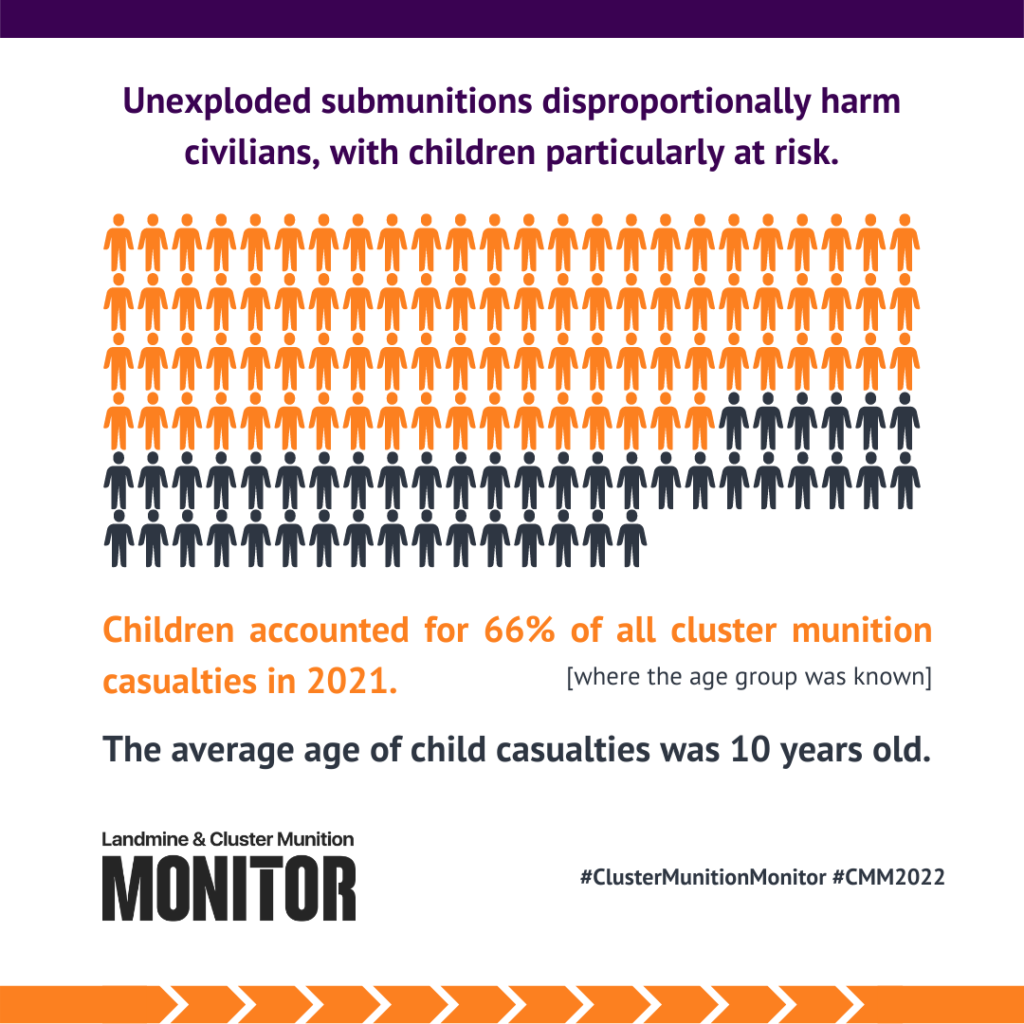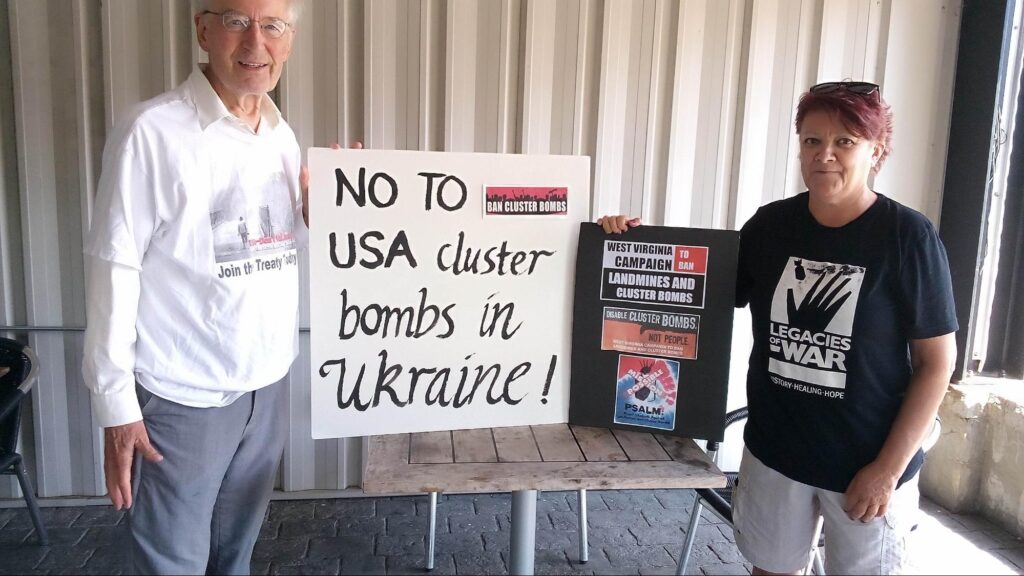
U.S. Cluster Munition Transfer to Ukraine Ignores History of Civilian Harm
By: Bonnie Docherty
Originally Published in: Just Security
President Joe Biden’s recent decision to transfer U.S. cluster munitions to Ukraine will exacerbate a humanitarian crisis and break with a widely followed international norm. The move encourages the proliferation of weapons that have been banned by over 120 countries because they endanger civilians both during strikes and for months, years, and even decades afterward. Having witnessed the gruesome impact of cluster munitions first-hand, I find the U.S. rationale for transferring them weak on multiple fronts.
Cluster munitions, which Russia has used extensively in Ukraine, disperse dozens or hundreds of smaller submunitions, or bomblets, across a broad area, the size of a city block. Each of these submunitions shatters into metal fragments that can tear off limbs and inflict fatal wounds. They cause civilian casualties at the time of attack because they cannot discriminate between soldiers and civilians. In addition, many do not explode on impact, lingering like landmines and posing an ongoing threat to the local population.
In news conferences on July 7, U.S. government officials justified the transfer of artillery projectiles containing cluster submunitions known as Dual Purpose Improved Conventional Munitions (DPICM) on several grounds. National Security Advisor Jake Sullivan and Undersecretary of Defense for Policy Colin Kahl contended that Ukraine already faces a massive challenge to clear unexploded ordnance, that technological and targeting safeguards will reduce risks, and that Ukraine needs more ammunition to defeat Russian forces.
These arguments, however, do not heed the lessons of earlier use of such submunitions by the U.S. and other countries that illuminate the dangers of deploying cluster munitions to the battlefield. Listening to White House and Pentagon spokespersons brought to mind interviews, images, and evidence from my field research with Human Rights Watch, which illustrate why this transfer is profoundly troubling.
Every Submunition Presents a Danger
While acknowledging that cluster munitions harm civilians, U.S. officials argued that using them will not significantly worsen the situation in Ukraine because the country already has to clear large numbers of Russian munitions, including submunitions and landmines. In addition, Ukraine has pledged to record where they use the weapons, and the U.S. has committed to support clearance efforts.
This reasoning ignores the threats to individual civilians waiting for their land to be cleared. Every unexploded submunition endangers a curious child, a farmer plowing a field, or a refugee returning home. The submunitions’ presence also slows reconstruction.
Children are the most common victims, as my Human Rights Watch colleagues and I found in Iraq in 2003. There, the U.S. widely used cluster munitions containing DPICM submunitions, including M42 and M46 submunitions for artillery projectiles, and M77 submunitions for rockets.
“Cluster bombs sometimes look like beautiful things,” a doctor at Iraq’s Najaf Teaching Hospital explained to us at the time. “Children like to play with them. [They] are here and there, everywhere on farmland.” Twelve-year-old Abbas Hussain, who was at that hospital, picked a submunition up on a road, thinking it was a toy, but it exploded and ripped off half of his hand.
DPICM submunitions are particularly attractive to children because they resemble a bell with a loop of ribbon at the end. “It’s nice for carrying,” one U.S. military officer told me in Baghdad, describing the threat to children. In Ditsi, Georgia, in October 2008, I interviewed Omar Mindiashvili, a displaced person who had recently returned home. He caught his 13-year-old daughter, Salome, swinging a Georgia-fired M85 submunition, which she had found on the roof of their porch, by its ribbon. Fortunately, he recognized the danger from a “risk education” TV advertisement and stopped her before it detonated.
Rami Ali Hassan Shebli was not as lucky. In October 2006, the 12-year-old boy picked up a strange object in a field near his village of Halta, in south Lebanon. Rami wanted something to toss back at his older brother Khodr, who was dropping pinecones on him from a tree. A bystander recognized the object as a submunition and yelled for Rami to drop it. The submunition exploded when Rami’s hand was behind his ear, killing him instantly. My team and I arrived as two men shoveled bloody dirt into a box and Lebanese Army deminers destroyed 15 unexploded DPICM submunitions, all left from an Israeli cluster munition attack in an adjacent field.
Cluster munitions can also impede or cause casualties among friendly forces. A British officer, Col. Gil Baldwin, described encountering a field of unexploded submunitions, launched by the U.S.-led coalition, just 500 meters after crossing the border from Kuwait into Iraq in 2003. “The first night [of the war],” he told me, “the lead vehicle of our convoy [drove] straight into a cluster bomb field. The corporal [who found the DPICM submunitions] came out white-faced…. It took half an hour to get out.”
Clearance is dangerous, time-consuming, and expensive. Doing it well involves highly trained professionals with specialized equipment carefully marking and examining land meter-by-meter. But environmental conditions, such as heavy rains or flooding, can frustrate even the most careful demining operations. Adding any number of submunitions to the contamination can slow clearance operations and exacerbate the danger for demining teams and for civilians who seek to return home. To make matters worse, residents often try to remove submunitions from their land or their homes themselves, which puts them at risk and complicates clearance for the professionals.
19 members of the House of Representatives issued the following statement on the White House’s decision to transfer cluster munitions to Ukraine:
“The United States has a proud commitment to global moral leadership and the defense of human rights. That commitment should have included refusing to transfer cluster munitions that, by design, hold a serious risk of severe harm to civilians.
“Cluster munitions have been banned by nearly 125 countries under the United Nations Convention on Cluster Munitions because of the indiscriminate harm they cause, including mass civilian injury and death. That is why since Fiscal Year 2010, and in all subsequent appropriations bills including last year, Congress has enacted severe restrictions on the transfer of cluster munitions with bipartisan support. It is also why Members of Congress from across the political spectrum have long called on the United States to join global allies and sign on to that U.N. Convention, and why they joined nearly 40 civil society organizations to urge the Biden Administration not to engage in any transfer of cluster munitions.
“Experts warn that the likelihood of leaving behind dangerous unexploded material is dependent on several factors and potentially much higher than the Pentagon has estimated. The reality is that there is no such thing as a safe cluster bomb — and using or transferring them for use hurts the global effort to eradicate these dangerous munitions, taking us down the wrong path. The U.S. history of using cluster munitions — particularly the legacy of long-term harm to civilians in Southeast Asia — should prevent us from repeating the mistakes of our past.
“We can and will continue to support our Ukrainian allies’ defense against Russia’s aggression. However, that support does not require we undermine the United States’ leadership in advocating for human rights around the world, enable indiscriminate harm that will only further endanger Ukrainian civilians, or distance us from European partners in the conflict who are signatories to the U.N. Convention opposing cluster munitions.
“The White House’s announcement runs counter to Congress’s restrictions on the transfer of these weapons and severely undermines our moral leadership. It underscores the work still ahead to press the U.S. to join the international community in banning the use of cluster munitions.”
As the executive director of the Arms Control Association, Daryl Kimball, explained in an article for Just Security last week, providing these weapons to the Ukrainian government in the name of aiding their campaign will be counterproductive: “Cluster munitions cannot differentiate between a Russian solider and a Ukrainian solider. They would put advancing forces (and civilians) at risk of encountering unexploded ordnance from earlier bombardments. U.S. forces experienced serious fratricide dangers when it employed cluster munitions in Iraq in the 1990s.”
Editorial: Biden cluster bomb decision embraces Putin’s immorality…
“Stooping to the level of an amoral opponent is not the act of a confident world power, and no battlefield advantage justifies knowingly putting civilians, especially children, at risk for decades to come”.
https://www.post-gazette.com/opinion/editorials/2023/07/12/biden-ukraine-russia-cluster-bombs-munitions/stories/202307120022


